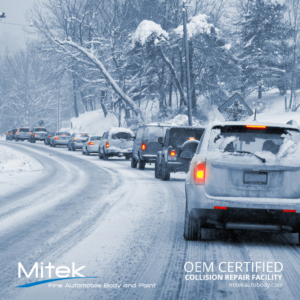I. The Unique Demands and Challenges of Canadian Winter Driving
Oh, Canada! There are many things to love and appreciate about our country, but getting from A to B safely in the wintertime certainly doesn’t top the list.
According to a Workers’ Safety and Compensation Commission article, roughly one-third of all accidents in Canada happen on snowy or icy roads, and 5% occur during a snowfall. The RCMP found that most single vehicle accidents occur from October to December, and accident claims in some recent years grew as much as 50% through December and January. Those are some sobering statistics.
Fortunately, there are steps you can take to help you navigate winter roads with confidence. From basic winter car maintenance tips and winter driving strategies to collision avoidance and navigation techniques, let’s take a look at what you need to know to help you safely reach your destinations over the next few months.
II. Winter Car Maintenance in Canada
In order to be prepared for winter driving, you need to start attending to certain tasks well before the freezing temperatures hit. The internet is full of handy checklists and articles—like this one courtesy of CAA—that cover all the most important pre-winter preparations you need to make.
At the very least, you should:
- Top up windshield fluid and inspect and replace wipers as needed.
- Inspect tires for wear and replace if needed – see below for more information.
- Change the oil and make sure you are using the right formulation for cold temperatures.
A Word About Winter Tires
When tires become rigid, they can’t grip the road effectively. Summer tires start to harden at 7 C, and “all-season tires” were not created with Canadian seasons and temperatures in mind… they also harden up at around -10 C. However, winter tires are engineered with a special kind of rubber that stays pliable in temperatures as low as -40 C. Now that’s more like it!
Winter tires must be in good shape, with a healthy degree of tread, to be the most effective. Tires that have lost about half their tread won’t look much different, yet their performance can take quite a hit—acceleration drops by about 14%, and stopping distance on wet surfaces increases by about 7%.
III. Winter Driving Safety Tips
Let’s start with the basics: in order to stay safe, you need to be able to see clearly, and to be clearly seen by other drivers. So allow extra time before starting out in order to clear all snow from the vehicle.
It’s also a good plan to have some kind of emergency kit on board. You can buy kits that are already assembled, or put together your own. CAA provides a comprehensive list of items you should include for maximum safety.
Even If You Do Nothing Else, Do This …
You simply can’t drive the same in inclement weather as you do when the roads are clear and dry. Perhaps the most obvious (yet often ignored) tip that can make winter driving safer is to STAY EXTRA VIGILANT and SLOW DOWN — even slower than the posted speed limit if necessary.
Slower speeds give you more time to brake and react to hazards, reducing the chance that you will skid or spin out of control. You should also extend your follow distance by 5+ seconds so you’ll have extra leeway to react if you need to stop suddenly.
Winter Driving Techniques to Stay in Control
Certain driving techniques can also reduce the chance of losing traction:
- Avoid sudden braking or accelerating on snowy or icy surfaces! Accelerate slowly and gradually, and use gentle pressure on the brake.
- Use a low gear to avoid spinning tires and increase control on ice.
- When changing lanes, signal sooner than you usually do and make sure you have extra clearance.
- If you need to stop quickly, pump the brake intermittently to visually alert the driver behind you.
- When feasible, follow in the tire marks already made by other drivers.
How Your Car is Built to Help
If you have an anti-lock braking system (ABS) and you feel a pulsing when you push down on the pedal, do not let up on the pressure. Keep your foot where it is and let the ABS do what it’s designed for: helping you come to a safe, controlled stop.
Traction control swings into action when your car’s wheels lose grip, at which point it slows down rotation speed to account for the road surface. The only time you would consider turning off traction control is when your car is stuck, since it can prevent the wheel spinning action you need to get your car free.
V. Conclusion
As Canucks, we pride ourselves on our ability to power through these frigid months without batting an eye, but that attitude should not extend to winter driving. As a winter driver, the most dangerous mistake you can make is to assume you don’t need to take any special precautions. To stay safe as you get around, you have to make certain adjustments—to your winter car maintenance routine, your driving habits, and your attitude.
At Mitek, collision repair is our business, so we will always be here to help if winter driving conditions get the better of you. Above all, though, we want you to stay safe and injury-free! We sincerely hope the tips and information here will help you to avoid ever having to take advantage of our expertise.

